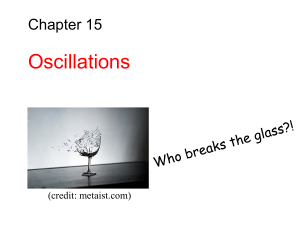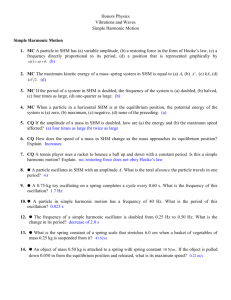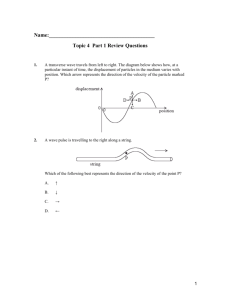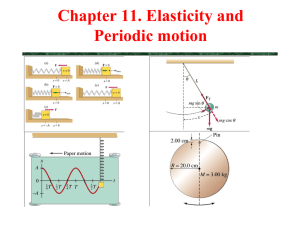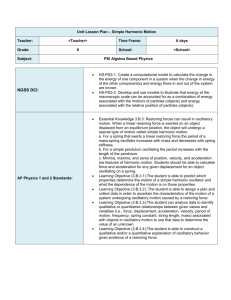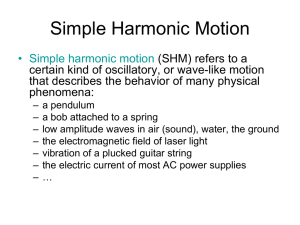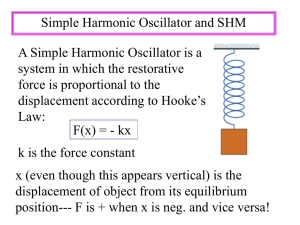OSCILLATIONS new .notes
advertisement
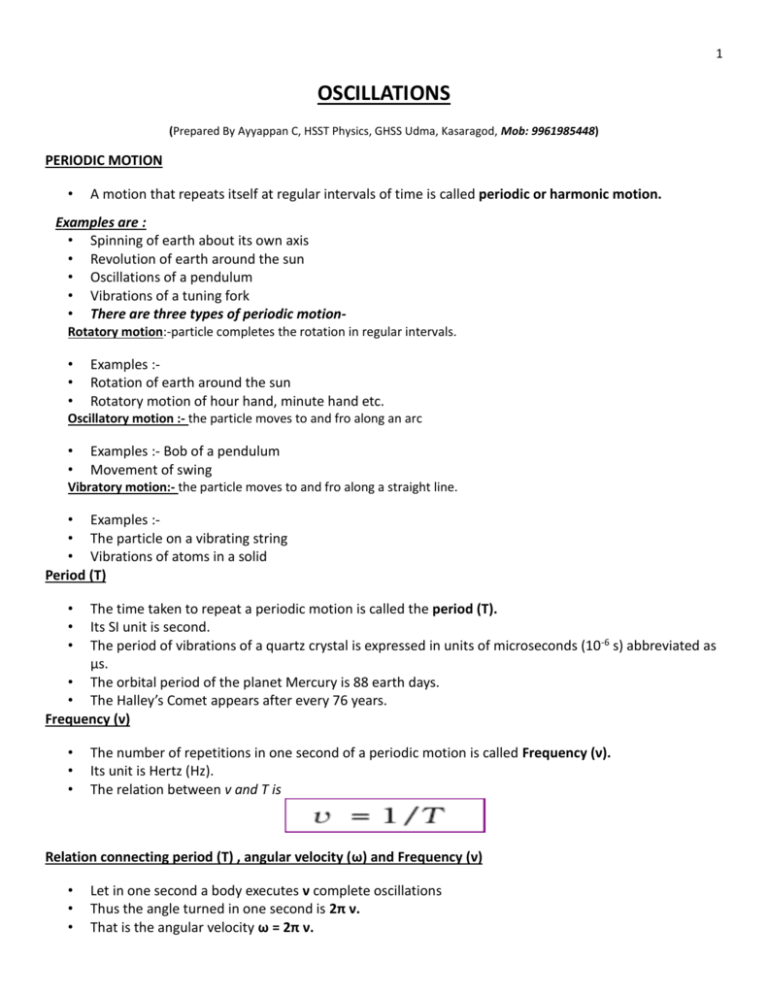
1 OSCILLATIONS (Prepared By Ayyappan C, HSST Physics, GHSS Udma, Kasaragod, Mob: 9961985448) PERIODIC MOTION • A motion that repeats itself at regular intervals of time is called periodic or harmonic motion. Examples are : • Spinning of earth about its own axis • Revolution of earth around the sun • Oscillations of a pendulum • Vibrations of a tuning fork • There are three types of periodic motionRotatory motion:-particle completes the rotation in regular intervals. • • • Examples :Rotation of earth around the sun Rotatory motion of hour hand, minute hand etc. Oscillatory motion :- the particle moves to and fro along an arc • • Examples :- Bob of a pendulum Movement of swing Vibratory motion:- the particle moves to and fro along a straight line. • Examples :• The particle on a vibrating string • Vibrations of atoms in a solid Period (T) • • • The time taken to repeat a periodic motion is called the period (T). Its SI unit is second. The period of vibrations of a quartz crystal is expressed in units of microseconds (10-6 s) abbreviated as μs. • The orbital period of the planet Mercury is 88 earth days. • The Halley’s Comet appears after every 76 years. Frequency (ν) • • • The number of repetitions in one second of a periodic motion is called Frequency (ν). Its unit is Hertz (Hz). The relation between v and T is Relation connecting period (T) , angular velocity (ω) and Frequency (ν) • • • Let in one second a body executes ν complete oscillations Thus the angle turned in one second is 2π ν. That is the angular velocity ω = 2π ν. 2 • Or ν = ω/2 π. • The period T = (1/ ν) = 2 π/ ω SIMPLE HARMONIC MOTION (SHM) • In SHM the restoring force on the oscillating body is directly proportional to its displacement from the mean position, and is directed opposite to the displacement DISPLACEMENT OF SHM The displacement of a particle vibrating back and forth about the origin of an x-axis between the limits +A and –A is given by • Where A, ω, and φ are constants. Displacement – Time graph of SHM . 3 Amplitude(A): • It is the magnitude of the maximum displacement of the oscillating particle Phase: • • The time varying quantity, (ωt + φ ), is called the phase of the motion. Phase describes the state of motion at a given time. Phase constant (or phase angle): • • The constant φ is called the phase constant. The value of φ depends on the displacement and velocity of the particle at t = 0. Angular frequency (ω): • • The constant ω, called the angular frequency of the motion, is related to the period T. Let φ = 0; then • Since the motion is periodic with period T, • Therefore • Thus, the angular frequency is, • The SI unit of angular frequency is radians per second. SIMPLE HARMONIC MOTION AND UNIFORM CIRCULAR MOTION • Simple harmonic motion is the projection of uniform circular motion on a diameter of the circle. 4 VELOCITY IN SIMPLE HARMONIC MOTION The displacement of SHM is given by Differentiating with respect to time , we get the velocity • • The negative sign appears because the velocity component of P is directed towards the left. We know sin (t ) 1 cos 2 (t ) • Thus v (t ) A 1 cos 2 (t ) • Or v (t ) A2 x 2 (t ) Case I • • At mean position, x=0 Then magnitude of velocity vmax A 5 Case II • • At extreme positions, x A Then vmin 0 ACCELERATION IN SHM • • • A particle executing a uniform circular motion is subjected to a radial acceleration a directed towards the centre. Differentiating the velocity we get the acceleration as Thus in SHM, the acceleration is proportional to the displacement and is always directed towards the mean position. Case I • • At mean position , x=0 Thus acceleration amin o Case II • At the extreme positions , x A a max A 2 6 FORCE LAW FOR SIMPLE HARMONIC MOTION • From Newton’s second law of motion relates the force acting on a system and the corresponding acceleration produced • Therefore • Since the force F is proportional to x rather than to some other power of x, such a system is also referred to as a linear harmonic oscillator. Systems in which the restoring force is a nonlinear function of x are termed as non-linear harmonic or anharmonic oscillators. • DIFFERENTIAL EQUATION OF SHM • • • The restoring force acting on a particle in SHM is given by F = -kx From Newton’s law we have F=ma 7 • But a • Thus d 2x dt 2 d 2x m 2 kx dt • Or d 2x kx 0 2 dt m • That is d 2x 2 x0 2 dt • Where 2 k m ENERGY IN SIMPLE HARMONIC MOTION • A particle executing simple harmonic motion has kinetic and potential energies Kinetic Energy (K) • The kinetic energy (K) is given by • Thus kinetic energy is a periodic function of time, being zero when the displacement is maximum and maximum when the particle is at the mean position. Since the sign of v is immaterial in K, the period of K is T/2. • 8 Potential Energy(PE) • The spring force F = –kx is a conservative force, with associated potential energy • Hence the potential energy of a particle executing simple harmonic motion is obtained as • Thus the potential energy of a particle executing simple harmonic motion is also periodic, with period T/2, being zero at the mean position and maximum at the extreme displacements. Total Energy(E) • • The total energy, E, of the system is, • That is • The total mechanical energy of a harmonic oscillator is thus independent of time. 9 SOME SYSTEMS EXECUTING SIMPLE HARMONIC MOTION Oscillations due to a Spring • • • • • • • • The simplest observable example of simple harmonic motion is the small oscillations of a block of mass m fixed to a spring, which in turn is fixed to a rigid wall. The block is placed on a frictionless horizontal surface. If the block is pulled on one side and is released, it then executes a to and fro motion about a mean position. At any time t, if the displacement of the block from its mean position is x, the restoring force F acting on the block is, The constant of proportionality, k, is called the spring constant, its value is governed by the elastic properties of the spring. A stiff spring has large k and a soft spring has small k. The equation is same as the force law for SHM and therefore the system executes a simple harmonic motion. The frequency 10 • The period, T, m T 2 k The Simple Pendulum • • • • • • • • • • • • A simple pendulum, consists of a particle of mass m (called the bob of the pendulum) suspended from one end of an unstretchable, massless string of length L fixed at the other end. The bob is free to swing to and fro in the plane of the page, to the left and right of a vertical line through the pivot point. The forces acting on the bob are the force T, tension in the string and the gravitational force. The string makes an angle θ with the vertical. We resolve the force Fg into a radial component Fg cos θ and a tangential component Fg sin θ. The radial component is cancelled by the tension, since there is no motion along the length of the string. The tangential component produces a restoring torque about the pendulum’s pivot point. The torque always acts opposite to the displacement of the bob so as to bring it back towards its central location. The central location is called the equilibrium position (θ = 0), because at this position the pendulum would be at rest if it were not swinging. The restoring torque τ is given by Where the negative sign indicates that the torque acts to reduce θ, and L is the length of the moment arm of the force Fg sin θ about the pivot point. For rotational motion we have 11 • • where I is the pendulum’s rotational inertia (moment of inertia) about the pivot point and α is its angular acceleration about that point. Thus • Substituting the magnitude of Fg, i.e. mg, we have, • Or • If θ is small sin , therefore mgL sin I • mgL I • That is, the angular acceleration of the pendulum is proportional to the angular displacement θ but opposite in sign. Thus the motion of a simple pendulum swinging through small angles is approximately SHM. • Comparing equations • The angular frequency • And Period a(t ) 2 x(t ) and mgL , we get I I T 2 mgL • • All the mass of a simple pendulum is centred in the mass m of the bob, which is at a radius of L from the pivot point. Therefore, for this system, we can write • Thus 12 T 2 L g DAMPED SIMPLE HARMONIC MOTION • • • • • • • The SHM which dies out eventually due to the dissipative forces acting on it is called damped simple harmonic oscillation. Eg: oscillations of a simple pendulum. In damped oscillations, although the energy of the system is continuously dissipated, the oscillations remain apparently periodic. Consider a block of mass m oscillates vertically on a spring with spring constant k. The block is connected to a vane through a rod (the vane and the rod are considered to be massless). The vane is submerged in a liquid. The up and down motion of the vane displaces the liquid, which inturn, exerts an inhibiting drag force (viscous drag) on it and thus on the entire oscillating system. With time, the mechanical energy of the block spring system decreases, as energy is transferred to the thermal energy of the liquid and vane. • • • Let the damping force exerted by the liquid on the system be Fd. Its magnitude is proportional to the velocity v of the vane or the block. Thus • • • where b is a damping constant that depends on the characteristics of the liquid and the vane. The negative sign makes it clear that the force is opposite to the velocity at every moment. The restoring force on the spring is • Thus the total force acting on the mass at any time t is 13 • If a(t) is the acceleration of the mass at time t, then by Newton’s second law of motion • Or d 2x dx m 2 b kx 0 dt dt • The solution of this equation is of the form • Where • We can regard the solution as a cosine function whose amplitude, which is gradually decreases with time. • If b=0(there is no damping), then x (t ) A cos(t ) k m • • • These are expressions for the displacement and angular frequency of an undamped oscillator. If the oscillator is damped, the mechanical energy is not constant but decreases with time. Thus • Equation shows that the total energy of the system decreases exponentially with time. 14 Free Oscillations • • • • When a body is oscillated and left free , it executes oscillations for some time with a frequency. These oscillations are called free oscillations. The frequency of free oscillation is known as natural frequency. A person swinging in a swing without anyone pushing it or a simple pendulum, displaced and released, are examples of free oscillations. FORCED OSCILLATIONS AND RESONANCE • • • • • • • • When a periodic force is applied to maintain an oscillation, it is known as forced or driven oscillations. The frequency of forced oscillations is equal to the frequency of the applied force. In case of a system executing driven oscillations under the action of a harmonic force, two angular frequencies are important (1) the natural angular frequency ω of the system, which is the angular frequency at which it will oscillate if it were displaced from equilibrium position and then left to oscillate freely. (2) the angular frequency ωd of the external force causing the driven oscillations. Suppose an external force F(t) of amplitude F0 that varies periodically with time is applied to a damped oscillator. Thus The motion of a particle under the combined action of a linear restoring force, damping force and a time dependent driving force is given by • • Or 15 d 2x dx m 2 b kx F0 cos d t dt dt • • • The oscillator initially oscillates with its natural frequency ω. When we apply the external periodic force, the oscillations with the natural frequency die out, and then the body oscillates with the (angular) frequency of the external periodic force. The solution of the above equation is given by • Where A F0 m b 2 2 2 2 d 2 2 1 2 d • And • Where m is the mass of the particle and v0 and x0 are the velocity and the displacement of the particle at time t = 0. Special Cases 1. Small Damping, Driving Frequency far from Natural Frequency : In this case, ωdb will be much smaller than m(ω2–ω2d) and we can neglect that term. A m F0 2 d 2 If we go on changing the driving frequency, the amplitude tends to infinity when it equals the natural frequency 2. Driving Frequency Close to Natural Frequency • If ωd is very close to ω ,then m(ω2–ω2d) would be much less than ωdb. • Therefore 16 • • • • • • • • • Thus the maximum possible amplitude for a given driving frequency is governed by the driving frequency and the damping. The phenomenon of increase in amplitude when the driving force is close to the natural frequency of the oscillator is called resonance. All mechanical structures have one or more natural frequencies, and if a structure is subjected to a strong external periodic driving force that matches one of these frequencies, the resulting oscillations of the structure may rupture it. The Tacoma Narrows Bridge at Puget Sound, Washington, USA was opened on July 1, 1940. Four months later winds produced a pulsating resultant force in resonance with the natural frequency of the structure. This caused a steady increase in the amplitude of oscillations until the bridge collapsed. To avoid rupture of bridges due to resonance , marching soldiers break steps while crossing a bridge. Aircraft designers make sure that none of the natural frequencies at which a wing can oscillate match the frequency of the engines in flight. In an earthquake, short and tall structures remain unaffected while the medium height structures fall down. This happens because the natural frequencies of the short structures happen to be higher and those of taller structures lower than the frequency of the seismic waves. #####
